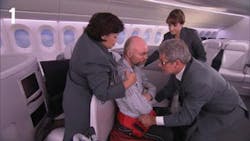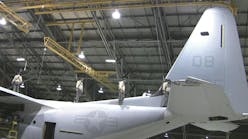The Vancouver Paralympics are in full swing. I admit to be a sports nut and will watch just about any sports — hey, this is without doubt awesome; some of the most impressive performances I have ever witnessed.
As you read this the medals will have been won, the personal bests recorded and new benchmarks set ready for next time. The athletes will by now be home and enjoying good memories, win lose or draw.
The airlines, airports and support crews can take a bow. They played a vital part in getting the athletes, support teams and equipment to Vancouver and back again.
No medals but appreciation I’m sure for the effort, along with the ground transportation crew, accommodation and catering staffs that were involved.
For the record, 650 athletes participated from 45 nations — another record.
In the business end of providing a service to disabled passengers, sports people are usually the least of our problem. Generally they are fit, willing and able to offer assistance to airline personnel and they are frequent travellers; they know the routine.
At the other end of the spectrum — passengers with severe mobility problems, often elderly perhaps heavy and not in very good health represent a challenge. They must be treated with respect and dignity on their journey but the reality is that air travel is not always a good experience.
Someone reading this will have the statistics but anyone who spend their days at an airport knows that the numbers have increased over the years, particularly passengers accompanied by a nurse or carer, assisted with an IV or oxygen device.
Some low-cost carriers have pricing policies that discourage passengers with any special handling needs, while still keeping just inside the legislative envelope that prohibits discrimination.
For the airlines that have been around awhile and are geared to handle disabled passengers, it is often left to the more senior service agents to drive the electric carts or push the wheelchair the length of the terminal, negotiating security and customs before finally arriving at the gate and calling on the aid of other staff to get the passenger onboard and seated. Where there is no aerobridge this will involve a mechanical lifting hoist ride through the catering door, usually in the rain and wind.
That is all replayed on arrival at the other end.
There has to be a better way. Everyone knows that but over decades the airline manufacturers, ground handling designers and airlines have only ever tweaked around the edges.
In the meantime the incidence of manual handling injury has increased, passenger complaints have been ignored and the effort of the advocacy groups, who have made constructive suggestions, put in the too-hard basket again.
Enter Air New Zealand
Early in 2008 Air New Zealand commissioned an independent review of the disabled passenger handling processes and procedures. Subsequent to the review, an internal steering group was established consisting of senior managers from across the business and sponsored by the group general manager of the international airline. The steering group considered the disabled passenger experience end-to-end and opportunities for improving handling procedures, assistive equipment and staff training.
For Air New Zealand the Pacific route to the West Coast has long been a flagship.
Upgraded regulations implemented by the United States Dept. of Transportation relating to nondiscrimination on the basis of disability in air travel were imminent and these were taken into consideration. In addition, the handling of disabled passengers was an important consideration with the imminent introduction of the new B777-300 fleet.
The airline identified staff manual handling tasks associated with boarding and deplaning of physically disabled passengers as a significant risk. Check-in service agents, ground handlers and cabin crew were all represented in the incident reporting process. The incident numbers were not significant, but risks were clearly identified.
Management took up the committee recommendations. These included design and engineering solutions, and process changes supported by new equipment and staff retraining — a major undertaking.
New equipment included power-driven wheelchairs at all major domestic airports. Two types, one for general terminal use and another narrow model that could be used as a boarding chair.
The design included a new on-board wheelchair to facilitate a level transfer from chair to chair and from chair to the cabin seat. Lifting had just been eliminated. A local New Zealand wheelchair manufacturer was assigned the task of developing a prototype that could be tested and commented on by disability advocacy groups and frequent flyers who have a mobility issue.
All that takes time, money and commitment.
For the cabin crew the move from the chair into the seat is never easy. In some cases the passenger or carer can assist, often that is not possible.
Air New Zealand devised a system using a transfer belt, slide sheet and slide board — a modification of techniques used in physiotherapy setting. This is made much easier when the wheelchair height and the aircraft seat height are aligned.
Some seat modifications were also designed for future business premier and premium economy class seating. This required the involvement of the design team and aircraft seat manufacturers.
Already, indications are looking very good. The systems have been in place four months. It is now in place on long-haul flights.
It is early, but the initial results have been encouraging. Staff manual handling injuries associated with disabled passenger handling are reducing. During this period Air New Zealand recorded reductions of up to 25 percent in flight delays and a 32 percent in minutes lost and associated costs.
The softer spin-off for the company has been a genuine connection between passengers, front line staff and the disabled community.
Going forward the changes will be rolled out on all flights — a big ask for an airline with a sizable network for a country as small as New Zealand, where air travel has always been high on a per capita basis.
Air New Zealand has shown leadership the industry would do well to follow.
Ground Handling and cabin service for disabled passengers has been slowly improving but talk to frequent flyers with a disability and they will raise travel issues such as transportation interchange before they even reach the terminal, check-in and managing luggage. Invariably, the issue of paper work and forms is raised. Despite really good work that has been done by the U.S. Dept. of Transportation and European Union lawmakers, the devil is in the detail.
Some airports and airlines do it well — the majority still have a way to go. The community does have Web sites that rate facilities and service standard globally.
They do tell it like it is — well worth a visit and see how the service at your airport or airline scores.




